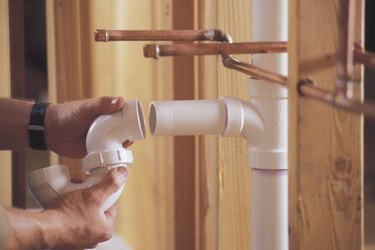
One of the most frustrating things about home improvement projects is running to the hardware store multiple times when you don't have something you didn't even know you needed. During a plumbing job, for example, you may discover that you're using PVC pipe but only have CPVC cement in your tool kit. Can you save yourself a trip and use what you have? Yes, but only if you're using CPVC cement on PVC pipe. You can't go the other way and use PVC cement on CPVC pipe.
Tip
Although it's best to use the correct adhesive when possible, you can use CPVC glue on PVC pipe. You can't, however, use PVC glue on CPVC pipe.
Video of the Day
PVC vs. CPVC
Perhaps because they sound so much alike, homeowners sometimes assume that CPVC pipe and PVC pipe aren't all that different. They're different enough, however, that using PVC where you need CPVC is quite problematic. For starters, the two materials are different colors. PVC is white, while CPVC is off-white, yellow, or gray. This may seem a superficial difference, but it helps you identify the type of pipe you have at a glance.
Video of the Day
Pipe makers also use different sizes for the two. PVC pipe is gauged using a system called nominal pipe size (NPS). NPS measures the thickness of the pipe walls, with schedule 40 and schedule 80 being the most frequently used. CPVC is sometimes measured using NPS standards, but it's often measured to the copper tubing size (CTS) scale instead. CTS isn't compatible with NPS.
Finally, CPVC can withstand temperatures that PVC can't. PVC can only withstand temperatures of up to 140 degrees Fahrenheit, making it a poor choice for hot water lines. CPVC, on the other hand, can withstand temperatures up to 200 degrees Fahrenheit. When the application demands it, you must use CPVC.
And Never the Two Shall Meet
Technically, with the right glue and procedure or with the right adaptors between them, you can connect PVC to CPVC pipe. Plumbing pros will tell you not to do so, however, and with good reason. You can't use PVC where you need CPVC. You can use CPVC where PVC would do, but it's wasteful to do so since CPVC is more expensive.
Simply put, a pipe run that uses both CPVC and PVC must stay below 140 degrees Fahrenheit. Once that's the case, it makes more sense to simply use the cheaper PVC.
How PVC and CPVC Solvents Work
To understand why swapping glues only works in one direction, you need to understand how these solvents work. CPVC cement is hardcore stuff. When applied to the pipe, the CPVC softens it, essentially melting it a little. As it does, the solvent creeps into the nooks and crannies to form a super-tight bond between the sections of pipe. It essentially welds the pipes together.
PVC glue doesn't pursue its work with quite as much gusto. It works in the same way as CPVC glue but uses different chemicals to achieve its goal. Remember that CPVC and PVC aren't made of the same materials, so joining pipes requires different bonding agents capable of creating different chemical reactions. PVC cement is strong and durable, but it won't resist temperatures above 140 degrees Fahrenheit.